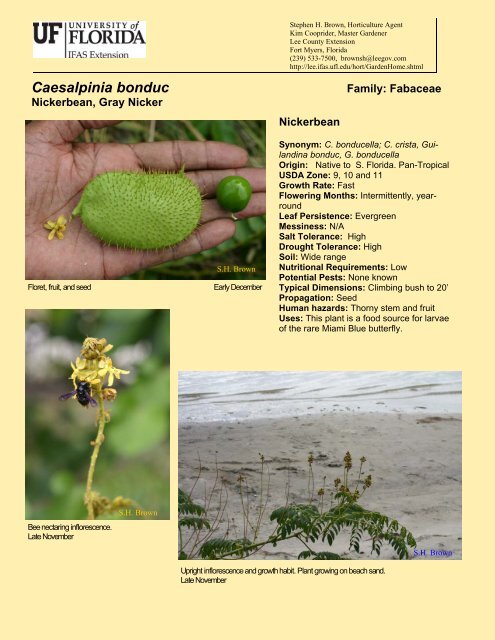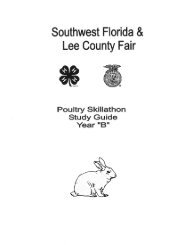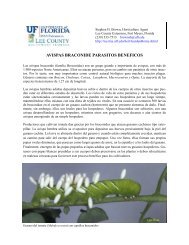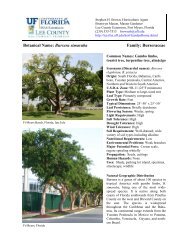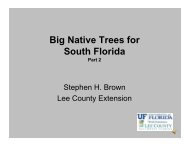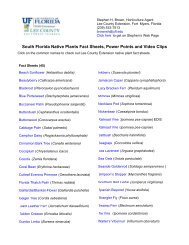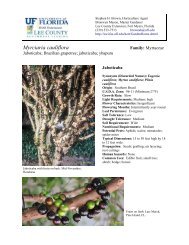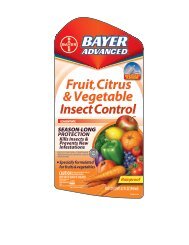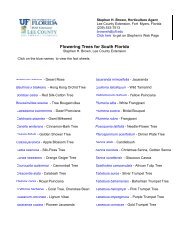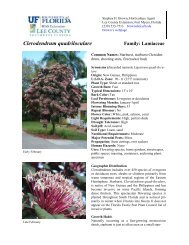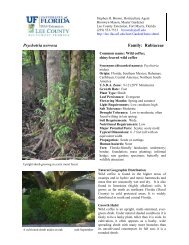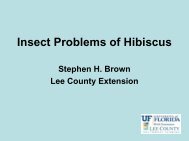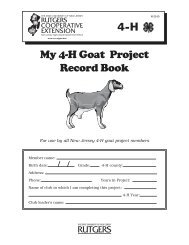Nickerbean - Lee County Extension - University of Florida
Nickerbean - Lee County Extension - University of Florida
Nickerbean - Lee County Extension - University of Florida
You also want an ePaper? Increase the reach of your titles
YUMPU automatically turns print PDFs into web optimized ePapers that Google loves.
S.H. Brown<br />
Stephen H. Brown, Horticulture Agent<br />
Kim Cooprider, Master Gardener<br />
<strong>Lee</strong> <strong>County</strong> <strong>Extension</strong><br />
Fort Myers, <strong>Florida</strong><br />
(239) 533-7500, brownsh@leegov.com<br />
http://lee.ifas.ufl.edu/hort/GardenHome.shtml<br />
Caesalpinia bonduc Family: Fabaceae<br />
<strong>Nickerbean</strong>, Gray Nicker<br />
Floret, fruit, and seed Early December<br />
Bee nectaring inflorescence.<br />
Late November<br />
S.H. Brown<br />
S.H. Brown<br />
<strong>Nickerbean</strong><br />
Synonym: C. bonducella; C. crista, Guilandina<br />
bonduc, G. bonducella<br />
Origin: Native to S. <strong>Florida</strong>. Pan-Tropical<br />
USDA Zone: 9, 10 and 11<br />
Growth Rate: Fast<br />
Flowering Months: Intermittently, yearround<br />
Leaf Persistence: Evergreen<br />
Messiness: N/A<br />
Salt Tolerance: High<br />
Drought Tolerance: High<br />
Soil: Wide range<br />
Nutritional Requirements: Low<br />
Potential Pests: None known<br />
Typical Dimensions: Climbing bush to 20’<br />
Propagation: Seed<br />
Human hazards: Thorny stem and fruit<br />
Uses: This plant is a food source for larvae<br />
<strong>of</strong> the rare Miami Blue butterfly.<br />
Upright inflorescence and growth habit. Plant growing on beach sand.<br />
Late November<br />
S.H. Brown
The stem <strong>of</strong> his prickly, aggressive, leguminous, climbing bush can grow to 2 inches or more in<br />
diameter and 18 to 20 feet in length. It is commonly found growing in coastal areas including<br />
tropical scrub, hammocks and mangroves. An opportunistic bush, nickerbean <strong>of</strong>ten grows to<br />
great heights by clamoring over other plants. The yellow, five-petaled florets occur year-round<br />
in clusters. Prickled, flattened seed pods appear in the fall, grow to about four inches in length<br />
and turn from green to brown, when they open and release 2 or 3 one-inch long seeds. The<br />
smooth beans, popular with sea bean collectors, are gray at maturity and have been used over<br />
the centuries in crafts and folk medicine.<br />
The seed pod is armed with many prickles and a single prominent prickle<br />
S.H. Brown<br />
S.H. Brown<br />
Clusters <strong>of</strong> seed pods Early December
Even Bipinnate leaf with 3-9 pairs <strong>of</strong> opposite<br />
pinnae<br />
Florets on inflorescence Inflorescence in form <strong>of</strong> raceme Group <strong>of</strong> inflorescence<br />
A single prominent prickle<br />
Armed stem and stipules<br />
Seeds in a pod<br />
The Institute <strong>of</strong> Food and Agricultural Sciences (IFAS) is an Equal Opportunity Institution authorized to provide research, educational information and<br />
other services only to individuals and institutions that function with non-discrimination with respect to race, religion, age, disability, sex, sexual orientation,<br />
martial status, national origin, political opinions or affiliations. U.S. Department <strong>of</strong> Agriculture, Cooperative <strong>Extension</strong> Service, <strong>University</strong> <strong>of</strong><br />
<strong>Florida</strong>, IFAS, <strong>Florida</strong> A. & M.


